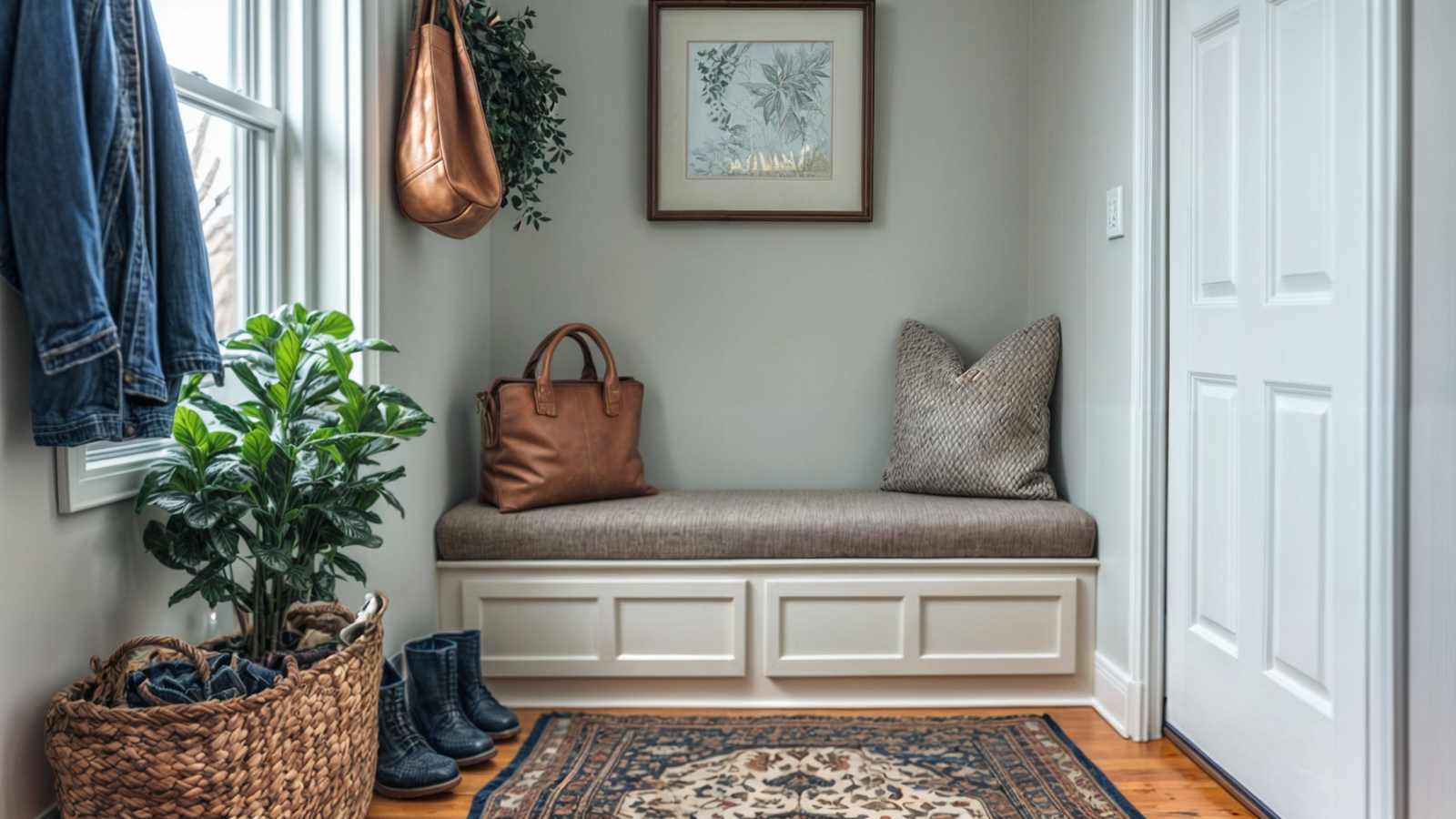Introduction: Why Every Home Needs a Tiny Mudroom
In today’s fast-paced world, having a well-organized and functional home is more important than ever. This is where the concept of a tiny mudroom comes into play. Despite its modest size, a tiny mudroom offers significant benefits that can transform your daily routine and enhance your home’s functionality.
One of the most compelling advantages of incorporating a tiny mudroom into your home is its ability to maximize organization. By providing a dedicated space for shoes, coats, and bags, you can keep clutter at bay and maintain an orderly entryway. This simple yet effective solution ensures that everything has its place, making it easier to find what you need when you’re rushing out the door.
Moreover, small mudroom ideas can be incredibly versatile and tailored to fit any space. Whether it’s utilizing wall hooks for hanging jackets or installing compact shelving units for storage bins, these creative solutions ensure that even the smallest areas are used efficiently. This not only helps in decluttering but also enhances the aesthetic appeal of your entryway.
In addition to organization benefits, having a well-designed mudroom offers practical home entryway solutions by acting as a barrier between the outdoors and indoors. It helps contain dirt and moisture brought in from outside activities, protecting your floors and keeping your living spaces cleaner.
Ultimately, investing in a tiny mudroom is about creating an inviting entrance that sets the tone for the rest of your home—a space that welcomes you with orderliness and ease every time you walk through the door. With these compelling advantages in mind, it’s clear why every home could benefit from this small yet mighty addition.
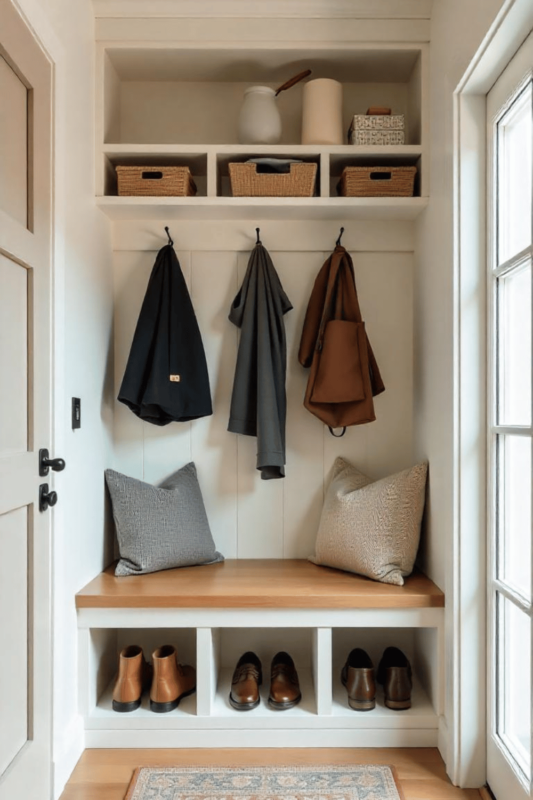
Innovative Space-Saving Ideas for Your Tiny Mudroom
Transforming a tiny mudroom into a functional and stylish space may seem challenging, but with the right approach, it’s entirely achievable. By embracing innovative space-saving ideas, you can create an organized and efficient area that meets all your needs without feeling cramped.
Start by considering space-efficient mudroom design principles. Opt for vertical storage solutions to make the most of limited square footage. Installing wall-mounted shelves or cabinets can provide ample storage for shoes, hats, and other essentials while keeping the floor clear. Additionally, using hooks on walls or doors offers a practical way to hang coats and bags without sacrificing valuable floor space.
Compact storage solutions are key when dealing with small spaces. Look for multifunctional furniture pieces like benches with built-in storage compartments or narrow console tables that double as shoe racks. These clever designs not only save space but also add functionality and style to your mudroom.
Don’t underestimate the power of creative small space hacks to maximize tiny spaces. Consider using baskets or bins to organize smaller items neatly; these can be tucked away under benches or on shelves for easy access. Incorporating mirrors is another effective strategy—they create an illusion of depth and brightness, making even the smallest mudrooms feel more open and inviting.
By implementing these innovative ideas, you can transform your tiny mudroom into a well-organized haven that maximizes every inch available while maintaining an aesthetically pleasing environment. Embrace these strategies today and enjoy a clutter-free entryway that welcomes you home in style!
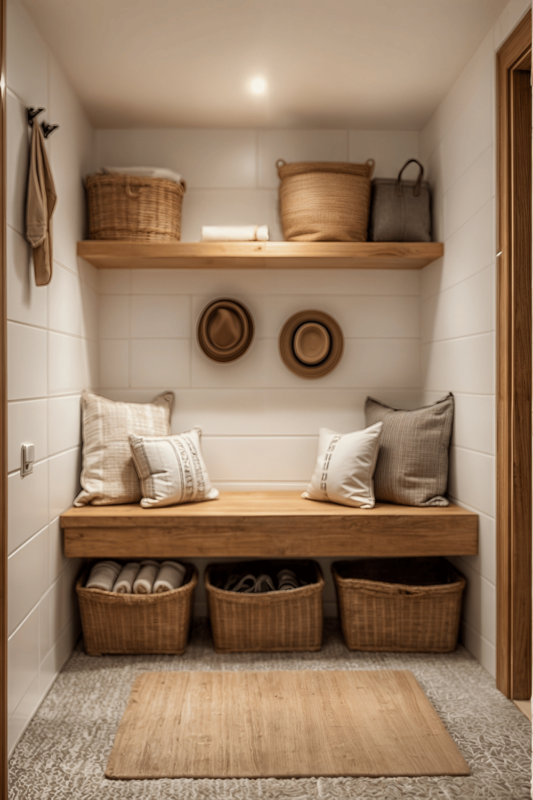
Design Essentials to Create a Welcoming Tiny Mudroom
Creating a welcoming tiny mudroom is an art that combines functionality with style, transforming even the smallest of spaces into an inviting entryway. When considering mudroom decor ideas, it’s essential to focus on elements that enhance both aesthetics and practicality. Start by selecting a color palette that feels warm and inviting—soft neutrals or gentle pastels can work wonders in making a compact area feel more expansive and cozy.
Incorporating stylish storage solutions is another key aspect of designing tiny mudrooms. Think vertical: wall-mounted hooks, shelves, and cubbies can keep clutter off the floor while adding visual interest. Choose pieces that reflect your personal style to maintain cohesiveness throughout your home.
Welcoming entry design tips often emphasize lighting as a crucial element; in small spaces, natural light can be maximized with strategically placed mirrors to create an illusion of depth and openness. Additionally, consider adding layered lighting options such as sconces or pendant lights to ensure the space remains bright and inviting at any time of day.
Finally, pay attention to the details that make your mudroom truly yours—a colorful rug for warmth underfoot, a piece of artwork for personality, or even some greenery to bring life into the space. By thoughtfully combining these design essentials, you can craft an aesthetic small space that not only meets practical needs but also sets the tone for your entire home.
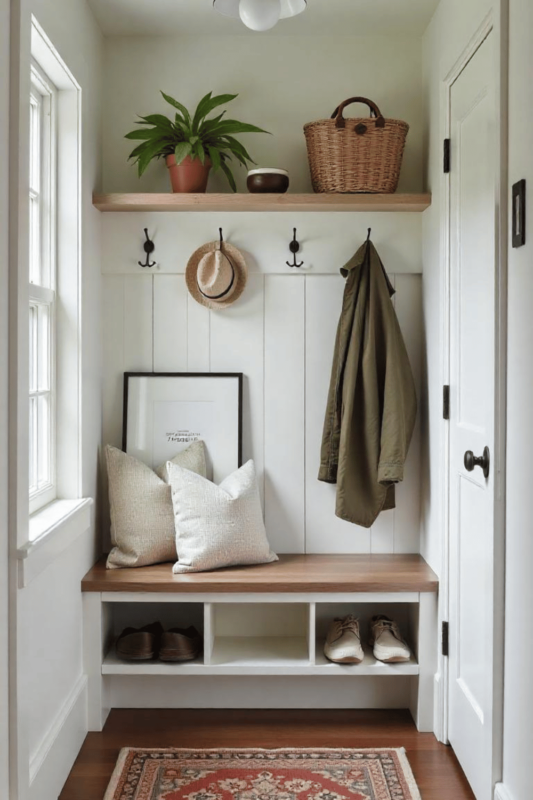
The Role of Smart Storage in Maximizing Your Tiny Mudroom’s Potential
When it comes to maximizing the potential of your tiny mudroom, smart storage solutions are not just a luxury—they’re an absolute necessity. Transforming a cluttered entryway into an organized and efficient space is easier than you might think with the right mudroom storage systems in place. By incorporating smart organization hacks, you can create a clutter-free environment that not only enhances functionality but also adds to the aesthetic appeal of your home.
Imagine walking into a tidy mudroom where every item has its designated spot—shoes neatly tucked away in cubbies, coats hung on hooks instead of thrown over chairs, and keys resting in their own stylish dish. Essential storage solutions such as wall-mounted shelves and multi-purpose benches can drastically change how you use this small space. These clever additions provide ample room for storing everyday items while keeping everything accessible.
Moreover, utilizing vertical space is one of the most effective ways to maximize your mudroom’s potential. Installing high shelves or overhead cabinets can help store seasonal items or less frequently used belongings without sacrificing precious floor area. With these smart strategies, even the smallest mudrooms can become organized havens that welcome you home with open arms and free up valuable time otherwise spent searching for misplaced items.
Incorporate these savvy solutions today and watch as your tiny mudroom transforms into a beacon of orderliness and efficiency—a testament to the power of intelligent design in small spaces.
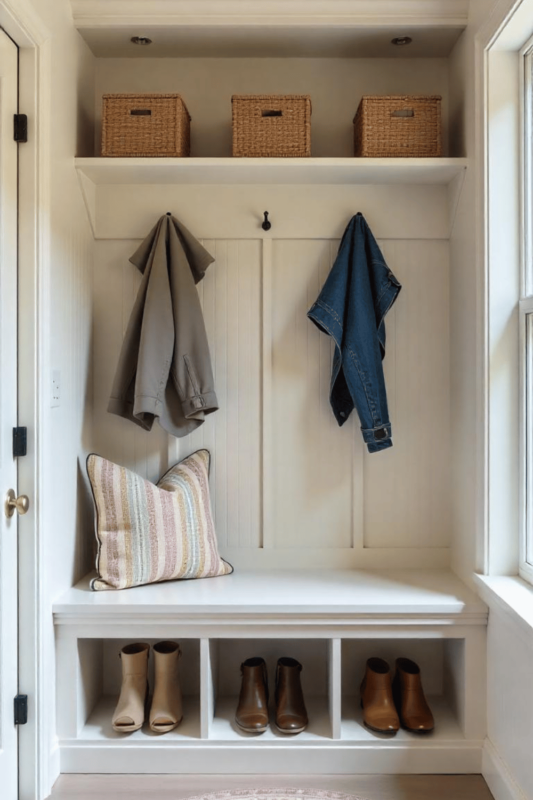
Clever Ways to Incorporate Multi-Functionality in Your Tiny Mudroom Design
Transforming a tiny mudroom into a multifunctional space can be both practical and stylish, offering you the best of both worlds. Multi-purpose mudrooms are becoming increasingly popular as homeowners seek to maximize every inch of their living spaces. With a little creativity and smart planning, even the smallest mudroom can serve multiple functions, making it an integral part of your home.
One clever way to incorporate multi-functionality is through dual-purpose furniture ideas. Consider investing in a bench with built-in storage underneath. This not only provides a convenient place to sit while putting on shoes but also offers hidden storage for items like umbrellas, hats, or seasonal gear. Another idea is to install wall-mounted hooks that double as decorative elements when not in use.
For those seeking functional tiny spaces inspiration, think vertically! Utilize wall space with shelves or cabinets that reach up to the ceiling for storing less frequently used items. You might also consider adding a fold-down table attached to the wall that can serve as an impromptu workspace or sorting station when needed.
Versatile room designs often include elements that adapt over time. For example, modular shelving systems allow you to rearrange components as your needs change—perfect for accommodating growing families or evolving lifestyles.
By embracing these innovative concepts in your small mudroom design, you’ll create a space that’s not only highly functional but also uniquely tailored to your lifestyle needs. So go ahead and let these ideas inspire you—your tiny mudroom has more potential than you might think!
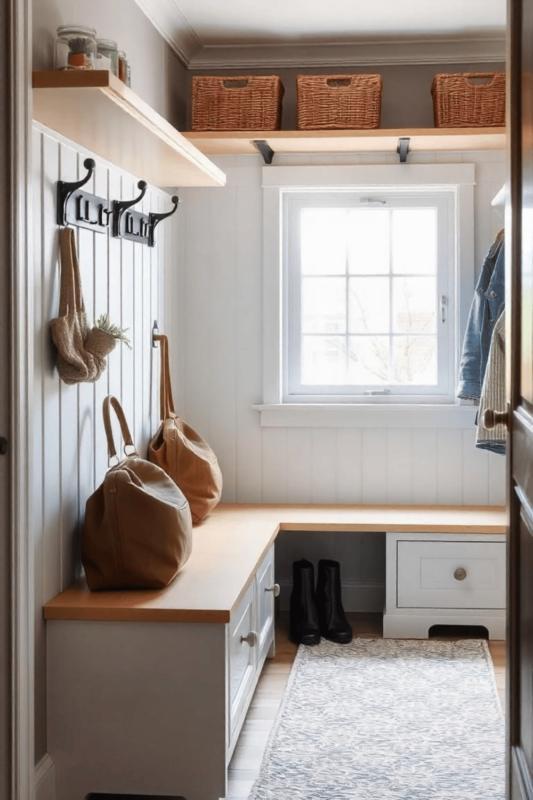
Tiny Budget? No Problem! Affordable Tips for Revamping Your Small Entryway Space
Revamping your small entryway doesn’t have to break the bank. With a bit of creativity and strategic planning, you can transform this often-overlooked space into a welcoming and stylish area without spending a fortune. Here are some budget-friendly remodeling tips for small spaces that will give your entryway the makeover it deserves, all for under $500.
Start by considering the power of paint. A fresh coat of paint can work wonders in any space, and your entryway is no exception. Opt for light, airy colors to make the area feel larger and more inviting. You can even create an accent wall with peel-and-stick wallpaper for added texture and personality without committing to permanent changes.
Next, focus on functional yet stylish storage solutions. A simple wall-mounted shelf or hooks can provide much-needed space for keys, bags, and coats while keeping the floor clear. Look for multi-purpose furniture like a bench with built-in storage or a slim console table that fits snugly against the wall.
Lighting is another crucial element that can dramatically change the ambiance of your entryway. Swap out outdated fixtures for modern options or add a chic table lamp to brighten up dark corners. Well-placed lighting not only enhances visibility but also adds warmth and character to your home’s entrance.
Don’t forget about accessories! Rugs, mirrors, and artwork are affordable ways to inject personality into your entryway without overwhelming it. A mirror not only serves as a last-minute check before heading out but also reflects light to make the space appear larger.
By incorporating these affordable home improvement projects under $500, you’ll create an inviting entryway that sets the tone as soon as guests step through your door—all while staying comfortably within budget!
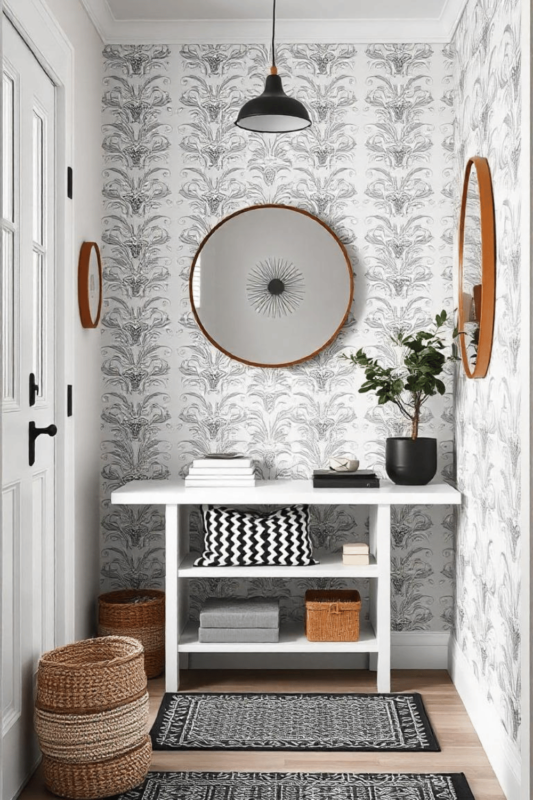
Conclusion: Embrace the Transformation—Create a Tiny Mudroom That Enhances Daily Life
As we reach the conclusion of our exploration into the transformative power of a tiny mudroom, it’s clear that embracing this change can significantly enhance your daily life. Imagine stepping into a space that effortlessly combines functionality with style, where every item has its place and every morning begins with an organized start. By creating a tiny mudroom, you’re not just adding an architectural feature to your home; you’re investing in a smoother, more efficient lifestyle.
Consider the benefits: no more scrambling for lost keys or shoes as you rush out the door. Instead, you’ll enjoy a serene transition from the chaos of the outside world to the comfort of your home. A well-designed mudroom can serve as a buffer zone that keeps dirt and clutter at bay while providing essential storage solutions for coats, bags, and outdoor gear.
Moreover, this transformation doesn’t require extensive renovations or large spaces. With thoughtful planning and creative use of vertical storage and multifunctional furniture, even the smallest areas can be turned into highly effective mudrooms. The key is to focus on your unique needs—whether it’s additional hooks for backpacks or seating for putting on shoes—and tailor your design accordingly.
In conclusion, by embracing the transformation and creating a tiny mudroom tailored to your lifestyle, you’re setting up an environment that enhances everyday living. It’s time to take that step towards greater organization and peace within your home—because even small changes can make a big difference in how we live our lives each day.
Frequently Asked Questions (FAQ)
1. Why is a well-designed mudroom essential for maintaining an organized home?
A well-designed mudroom keeps a home organized by containing dirt and debris, providing coat hanging, shoe storage, and bag shelves. It prevents outdoor messes from entering living spaces and streamlines routines with essential storage. A thoughtfully planned mudroom enhances your home’s aesthetic by combining style with function using benches or decorative baskets. Investing in a good mudroom creates an organized buffer that protects your home from clutter while enhancing functionality and beauty.
2. How can a tiny mudroom maximize storage without compromising style?
Maximize small mudroom storage by combining functionality with style. Use vertical space with wall-mounted shelves or cabinets for shoes and bags; open shelving keeps items accessible. Opt for multi-functional furniture like benches with built-in storage to reduce clutter. Match materials to home decor for seamless integration. Add hooks and pegboards for coats, hats, and keys using stylish hardware. Baskets or bins keep items tidy and add texture, creating a practical yet stylish mudroom.
3. What are the key elements to consider when designing a functional mudroom in limited space?
Designing a functional mudroom in limited space is possible by maximizing layout and flow. Use built-in storage like ceiling-high cabinets and multifunctional furniture, such as benches with hidden shoe storage. Hooks and wall racks keep items tidy. Ample lighting, like overhead lights, can make the space feel larger. Choose durable materials that match your home’s style, such as tile flooring or washable paint, to enhance functionality and style in tight spaces.
4. How does investing in a stylish mudroom enhance the overall aesthetic of your home?
A stylish mudroom elevates your home’s aesthetic and serves as an impressive entryway. It blends practicality with beauty, enhancing organization with chic storage like built-in benches or cabinetry. Sophisticated finishes, such as sleek tiles or warm wood accents, add elegance. A stylish mudroom can increase home value by showcasing thoughtful design choices that appeal to buyers. Personal touches like artwork or decorative lighting enrich the overall ambiance.
5. Can strategic design choices in a tiny mudroom increase your home’s value?
Boost your home’s value by enhancing small spaces like the mudroom. Use smart storage solutions like built-in cabinets to reduce clutter. Hooks for coats and bags maximize space for busy families. Choose durable flooring like ceramic tiles to handle traffic and moisture. Install overhead lights to make the area feel larger, and use neutral paint with decor accents to add personality without overwhelming the space. These improvements enhance daily living and marketability, making them a worthwhile investment.
6. Why should you prioritize durable materials when designing your mudroom?
Choosing durable materials for a mudroom ensures longevity and functionality. As high-traffic areas, they must handle muddy boots and wet coats. Durable tiles or waterproof panels are easy to maintain, ideal for busy homes. Sturdy wood or metal storage withstands daily use without wear. Quality materials enhance aesthetics and age better than cheaper options that fade or chip quickly. Investing in durability ensures an attractive, functional space year after year, balancing beauty and utility without compromise for convenience during renovations.
7. How can clever organization solutions transform even the smallest mudroom into an efficient space?
A well-organized mudroom enhances functionality, even in small spaces. Use wall-mounted hooks, cubbies, and baskets to maximize space. Install vertical shelves for storage without crowding the floor. Label bins for easy organization. Incorporate multi-functional furniture like benches with storage or coat racks with shoe compartments for utility and tidiness, efficiently storing outerwear, shoes, bags, and more to streamline routines.
>> Learn more: 10 Design Ideas for Tiny Garden: Small Garden, Big Dreams


